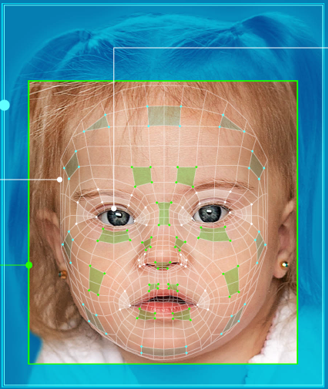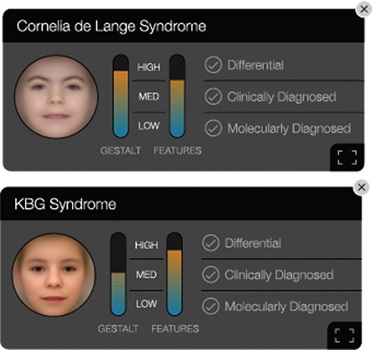For years, the 7-year-old’s symptoms had stumped his family and doctors: developmental delays, decreased muscle tone, a large skull and a number of medical problems that didn’t seem to tie together into a specific diagnosis.
In search of answers, his family turned to Children’s Wisconsin’s Genetics and Genomics Program, where physicians use cutting-edge genomics tools to solve medical mysteries.
If this boy had been referred in years past, Donald Basel, MD, medical director of the Genetics and Genomics Program, would’ve drawn on years of study, reference books and databases to  search for clues in a child’s physical differences — subtle variations from the norm in the length and spacing of the eyes, ears, nose and more that might indicate the pattern of a particular syndrome. The search could take days, weeks or even longer.
search for clues in a child’s physical differences — subtle variations from the norm in the length and spacing of the eyes, ears, nose and more that might indicate the pattern of a particular syndrome. The search could take days, weeks or even longer.
But now he just quickly snaps a picture with his smart phone, and an artificial intelligence app called Face2Gene instantly analyzes 88 points on the face and ranks the likelihood of various genetic syndromes in just a few seconds. “It never gives you a diagnosis,” Dr. Basel said. “It gives you an answer to consider.”
1
Armed with Face2Gene’s list of the 10 most likely possibilities and other clues in the boy’s medical history, Dr. Basel is able to pinpoint a likely diagnosis later confirmed by genetic testing: Coffin-Lowry Syndrome. This rare disease, which affects males more severely than females, can cause intellectual and developmental disabilities, physical abnormalities, and heart, hearing and vision problems. While there is no cure, early intervention can make a difference in a patient’s quality of life.
A powerful diagnostic tool
The app is a powerful diagnostic tool in a world in which there are as many as 7,000 rare diseases. But while individual rare diseases live up to their name — there are some patients at Children’s Wisconsin who are one of just a handful of known cases in the world — living with a rare disease is surprisingly common, affecting an estimated 25-30 million Americans. In the United States, a rare disease is defined as one that affects fewer than 200,000 people.
A study showed that Face2Gene’s software was able to correctly identify a diagnosis as a top 10 possibility 94 percent of the time, outperforming human experts. The app can help guide diagnoses and suggest possibilities that may not be on a physician’s radar.
But the deep-learning software is far from perfect: while Face2Gene includes more than 10,000 diseases, it needs 10 examples of a particular syndrome in its database before it can suggest it as a possibility, meaning it may not be able to identify ultra rare diseases.
An expert site
 Dr. Basel, who calls himself a “tech geek,” started using Face2Gene three years ago, becoming one of the first clinicians in the nation to use it. While the software quickly spread to clinics worldwide, Face2Gene classifies Children’s Wisconsin and the Medical College of Wisconsin as an “expert site,” meaning that the clinic’s confirmed diagnoses are used to improve the tool.
Dr. Basel, who calls himself a “tech geek,” started using Face2Gene three years ago, becoming one of the first clinicians in the nation to use it. While the software quickly spread to clinics worldwide, Face2Gene classifies Children’s Wisconsin and the Medical College of Wisconsin as an “expert site,” meaning that the clinic’s confirmed diagnoses are used to improve the tool.
“Machines can never replace humans,” Dr. Basel said. “The power of the machine is only as good as the information going in and the people who interpret it. The machine can only take all of the data and process it, but it can’t prioritize it.”
2
In Face2Gene’s Unknown Forum, physicians seek insights from experts on particularly puzzling cases. Still, Face2Gene can help speed up time to a diagnosis.
Exome sequencing — which involves analyzing 20,000 or so genes — is fast becoming the gold standard, but it’s expensive and not always an option for every family. By contrast, the Genetics Center is able to use Face2Gene with every patient, at no cost to families or insurance companies. Dr. Basel and his colleagues have used it with more than 1,000 patients so far.
A view of the future
 So, what’s the connection between someone’s face and a disorder that might affect other parts of the body?
So, what’s the connection between someone’s face and a disorder that might affect other parts of the body?
“We all start off as a mass of cells that rely on genetic control to develop segmented patterns that evolve into recognizable human embryos,” Dr. Basel said. “There are clues that we look for in terms of facial symmetry that might tell us what stage of development was affected. For example, the heart, ears and hands are all developing at the same time.”
But that’s only part of the picture. Physicians catalog a patient’s unusual features from head to toe, and also consider family health history and the child’s own medical history to reach a diagnosis.
Face2Gene is just one way that medicine is leveraging the power of big data. Dr. Basel envisions a day in which technology will be able to analyze all the information in a patient’s health record to provide a likely diagnosis. Such tools would be especially helpful in rural areas, where patients might have less access to specialty clinics. Already researchers are developing artificial intelligence to analyze everything from microscopic views of body tissues to radiographs of skeletal abnormalities.
“The future of health care is going to be very different in the next 15 to 20 years,” Dr. Basel said. “It’s great to be on the cutting edge of that technology. It’s fun to have access to it and, more importantly, be able to use it improve patient care.”







